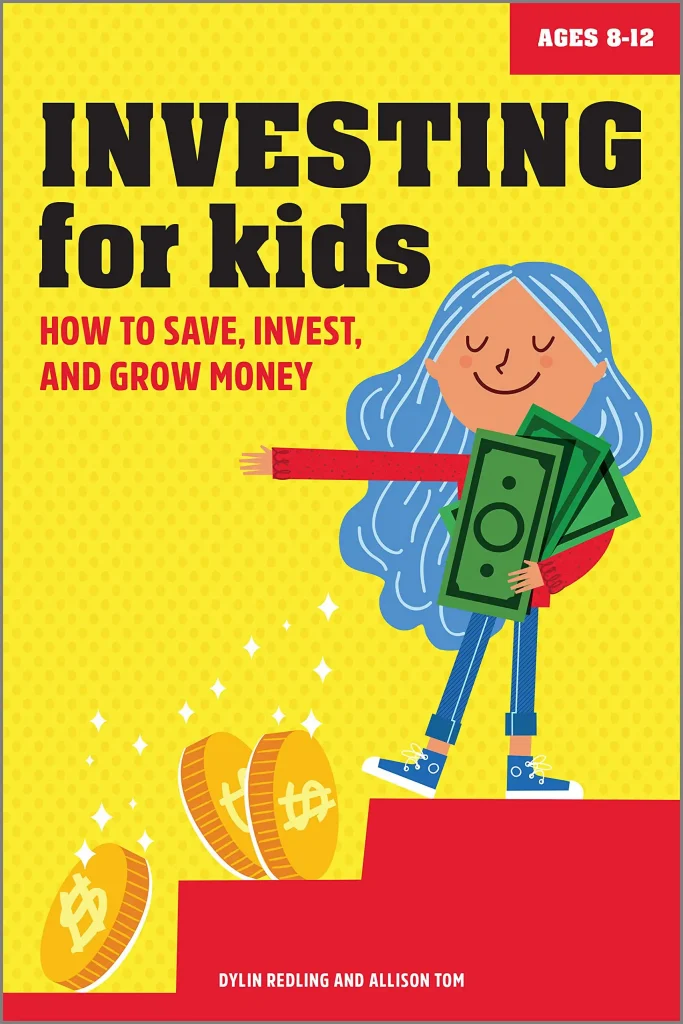This article has been reviewed by Sumeet Sinha, MBA (Emory University Goizueta Business School). Should you have any inquiries, please do not hesitate to contact at sumeet@finlightened.com.
Personal finance is not a topic that many kids want to discuss with peers. With so many other things going on in schools, personal finances are often left behind. The problem is this leaves parents and teachers scrambling for good books about money management for children of all ages from beginning readers to adults. There’s no shortage of options when it comes to the best personal finance books for kids worth reading, but these four will be your go-to guides:
Books on Personal Finance for Kids
1. “Investing for Kids: How to Save, Invest and Grow Money” by Dylin Redling and Allison Tom
This investing book for kids is a great way to teach them the basics of saving and investing. It covers topics such as setting up a savings account, choosing investments, and managing money. The book also includes a section on risk management.
The book starts with an introduction to saving and investing. It then covers the different types of investment vehicles, such as stocks, bonds, and mutual funds. The book also includes a section on risk management.
This book can be used as a resource for teaching kids about saving and investing. It can also be used by parents or guardians to help their children make informed decisions about their finances.
Good things about this book:
- Teaches kids the basics of saving and investing
- Includes a section on risk management
- Can be used by parents or guardians to help their children make informed decisions about their finances
2. “Blue Chip Kids: What Every Child (and Parent) Should Know About Money, Investing, and the Stock Market” by David W. Bianchi
Blue Chip Kids is a book that teaches children and parents about money, investing, and the stock market.
This book is a guide for children and their parents to learn about the stock market. It covers topics such as how the stock market works, what stocks are, and how to invest in them. The book also includes a glossary of terms and a list of resources for further reading.
What it teaches: The book covers a range of topics related to money and investing, including how to save money, how to invest in the stock market, and how to manage your finances.
Pros: The book is well-written and easy to understand. It provides a good introduction to the topic of money and investing for children and parents alike.
Cons: Some of the concepts covered in the book may be too complex for younger readers.
3. “Go! Stock! Go!: A Stock Market Guide for Enterprising Children and their Curious Parents” by Bennett Zimmerman and Kathy Kamel
This book is a guide for children and their parents to learn about the stock market. It covers topics such as how the stock market works, what stocks are, and how to invest in them. The book also includes a glossary of terms and a list of resources for further reading.
This book can be used by children and their parents to learn about the stock market. It can be read from cover to cover, or used as a reference guide when needed.
What you will learn:
- How the stock market works
- What stocks are
- How to invest in stocks
- Glossary of terms
4. “Teaching Kids to Buy Stocks: Stories and Lessons for Grown-Ups” by J J Wenrich
This book is designed to teach kids the basics of investing in stocks. It does this by using stories and lessons that grown-ups can relate to. The book covers topics such as what stocks are, how they are bought and sold, and how to pick a good stock. It also includes a section on teaching points for grown-ups who want to use the book to teach their kids about investing.
This investing book for kids is a great way to teach them the basics of saving and investing. It covers topics such as setting up a savings account, choosing investments, and managing money. The book also includes a section on risk management.
Bestseller Personal Finance Books
What You Will Learn: The basics of investing in stocks, including what they are, how they are bought and sold, and how to pick a good stock.
How to Use This Book: This book can be used by grown-ups to teach their kids about investing in stocks. It can also be used by kids on their own to learn about this topic.
Some key points that can be used when teaching kids about investing in stocks include:
- Stocks represent ownership in a company. When you buy a stock, you become a part owner of the company.
- Stocks are bought and sold on stock exchanges. The price of a stock is determined by supply and demand (how many people want to buy or sell the stock). ӨWhen you invest in stocks, you are taking on some risk. However, over the long term, stocks have proven to be a good investment.
- It is important to do your research before investing in a stock. You should look at things like the company’s financial statements, its competitive advantages, and the overall market conditions.
- There are different types of stocks, and each type has its own set of risks and rewards. Growth stocks tend to be riskier but also have the potential for higher returns. Value stocks tend to be less risky but also have lower return potential.
- You can invest in stocks through a broker or an online trading platform.
Conclusion: Help Children Learn Through The Books on Personal Finance For Kids
Personal finance is a topic that can be daunting for children, but it’s important to start early. By encouraging your kids to read books about personal finance, you can help your kids develop financial awareness and make sound decisions when it comes to their money. Not only will they understand the concepts better, but they’ll also have some great role models to look up to. If you’re looking for some good books on personal finance for kids, this list is a great place to start!
How Can My Child Start Saving Money?
Greenlight
Greenlight is a financial technology company that offers a debit card and app for kids ages 5-17. The Greenlight card is linked to a parent’s bank account and can be used anywhere Mastercard is accepted.
How it works: Parents set up an account and fund it with an initial deposit. They then add their child’s name and photo to the account and choose which stores or merchants they would like to allow their child to shop at. When the child makes a purchase, the funds are transferred from the parent’s bank account to the merchant.
Fees: There are no fees for parents to set up or use the Greenlight card. However, there is a $4.99 (for the basic plan – Greenlight Core) monthly fee for each child who has a Greenlight card.
Pros:
- Allows parents to teach their children about money management in a safe and controlled environment
- Parents can see all of their children’s spending in one place
- Children can use the card anywhere Mastercard is accepted
What is a Custodial Account? What Should I Look for in a Custodial Account?
A custodial account is an account that is set up by an adult for a minor child. The account is held in the child’s name, but the adult controls the money in the account until the child reaches adulthood.
What to look for in a custodial account: When you are looking at custodial accounts, you want to make sure that they offer good investment options and have low fees. You also want to make sure that the account is FDIC insured.
What is the Best Way to Invest $1,000 for a Child?
There are many different ways to invest money, but the best way to invest $1,000 for a child is to put it into a savings account or a 529 college savings plan. A 529 plan is an investment account that offers tax-free growth and can be used to cover qualified education expenses. The money in a 529 plan can be used for tuition, room and board, books, and other eligible expenses.
Why it is a good option to put money in a 529 college savings plan?
Putting money into a savings account or a 529 college savings plan is a good way to invest $1,000 for a child because it offers tax-free growth and can be used to cover qualified education expenses. The money in a 529 plan can be used for tuition, room and board, books, and other eligible expenses. This type of investment account is also one of the most flexible when it comes to withdrawals. You can take out money from a 529 plan at any time for any reason without penalty.
Why Should Kids Know About Saving and Investing?
Saving and investing are important because they help you grow your money. When you save, you’re putting away money that you can use in the future. Investing is a way to grow your money by putting it into things that will go up in value over time.
How to start saving and investing: You can start saving and investing by opening a savings account at a bank or credit union. You can also start investing by buying stocks, bonds, or mutual funds.
The different types of savings and investment accounts: There are many different types of savings and investment accounts. Some common ones are checking accounts, savings accounts, money market accounts, certificates of deposit (CDs), and individual retirement accounts (IRAs). Each type of account has its own features and benefits.
The benefits of saving and investing: The benefits of saving and investing include getting better returns on your money than if you kept it in a checking or savings account, having access to emergency funds when you need them, being able to retire comfortably, and leaving a financial legacy for your family.
Read also:
- 16 Best Personal Finance Books For Teens And Young Adults
- 8 Best Credit Cards For Teachers
- 4 Best Credit Cards For Nannies
- 9 Best Credit Cards for Wedding Expenses
- 10 Best Credit Cards For Consultants
- 8 Best Credit Cards For Golf Lovers
- 6 Best Credit Cards for Traveling Consultants
- How to Use Credit Card Responsibly: 7 Must-Have Credit Habits
- Plastic Money – 3 Huge Payment Networks – Visa, Mastercard, and American Express
- Apple Pay and Google Pay – Which Is Better Among Top 2 Services?
- 8 Cool Benefits of Obtaining A Personal Loan – When to Consider It?
- How Do Business Credit Cards Work? 5 Reasons You Should Get One


Read more
Popular Topics: Stocks, ETFs, Mutual Funds, Bitcoins, Alternative Investing, Dividends, Stock Options, Credit Cards
Posts by Category: Cash Flow | Credit Cards | Debt Management | General | Invest | Mini Blogs | Insurance & Risk Mgmt | Stock Market Today | Stock Options Trading | Technology
Useful Tools
Student Loan Payoff Calculator | Mortgage Payoff Calculator | CAGR Calculator | Reverse CAGR Calculator | NPV Calculator | IRR Calculator | SIP Calculator | Future Value of Annuity Calculator
Home | Blog
Our Financial Calculator Apps
Page Contents



















